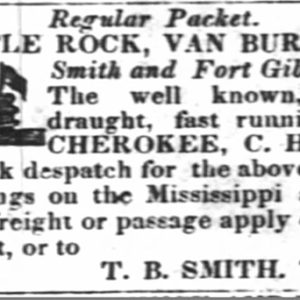calsfoundation@cals.org
Cherokee [Steamboat]
The Cherokee was a steamboat that sustained a devastating and deadly boiler explosion at Lewisburg (Conway County) on December 11, 1840.
The Cherokee, under the command of twenty-seven-year-old New York native Charles Harris, was advertised as a “well-known, very light draft, fast running steamboat.” The vessel made regular runs carrying passengers and cargo from New Orleans to Little Rock (Pulaski County), Fort Smith (Sebastian County), and Fort Gibson in the Indian Territory (present-day Oklahoma).
The steamboat arrived at the river town of Lewisburg around sunrise on December 11, 1840. After stopping for about fifteen minutes, the Cherokee pulled out into the Arkansas River, and almost immediately the flue of one boiler collapsed and another exploded, casting forth scalding steam and deadly debris. Eleven people were killed instantly, including a man standing on the shore who died when he was struck “by a piece of connection pipe, which passed through his neck,” as one newspaper reported. Six other badly injured people died within hours.
One newspaper account said that Captain Harris was asleep in his bunk when the explosion occurred and was “hurled from it into the after part of the ladies’ cabin, with such violence as to break his back.” Another said the captain was thrown about fifty yards.
A Helena (Phillips County) newspaper wrote that “one body was found 150 yards from the wreck, so mutilated it could not be recognized by anyone. Fragments of bodies, arms, legs, &c. have been found in every direction.” Another account stated that “the boat was literally torn to pieces and will be a total loss.” The Cherokee sank in five feet of water.
Harris was transported to Little Rock, where he stayed in a room at Chester Ashley’s house before dying the next day. The same Weekly Arkansas Gazette article announcing his death reported that an injured crew member and a passenger had both succumbed to their injuries at Lewisburg, raising the death toll of the Cherokee disaster to at least twenty.
The Cherokee catastrophe provides another example of the dangers of steamboat travel in Arkansas waters in the 1800, where boiler explosions also caused mass casualties on the Car of Commerce in 1828, the Rob Roy in 1836, the Persian in 1840, the J. Wilson in 1853, the Sultana in 1865, and the Miami in 1866.
For additional information:
“Died.” Weekly Arkansas Gazette, December 16, 1840, p. 3, col. 3.
“Explosion of the Cherokee.” Arkansas State Democrat and Helena Commercial Advertiser, December 24, 1840, p. 2.
“Regular Packet” [Advertisement]. New Orleans Times-Picayune, November 21, 1840, p. 3.
“Steamboat Explosion.” Boston Post, December 26, 1840, p. 2.
“Steamboat Explosion.” Baltimore Pilot and Transcript, December 28, 1840, p. 2.
“Terrible Steamboat Accident.” Louisville Courier-Journal, December 21, 1840, p. 2.
Mark K. Christ
Central Arkansas Library System
 Louisiana Purchase through Early Statehood, 1803 through 1860
Louisiana Purchase through Early Statehood, 1803 through 1860 Transportation
Transportation Cherokee Steamboat Ad
Cherokee Steamboat Ad  Cherokee Steamboat Article
Cherokee Steamboat Article 




Comments
No comments on this entry yet.